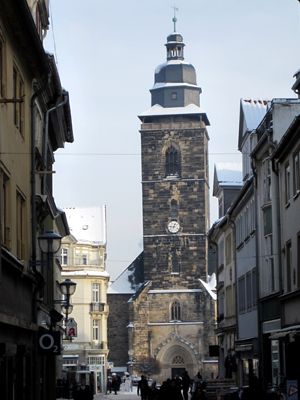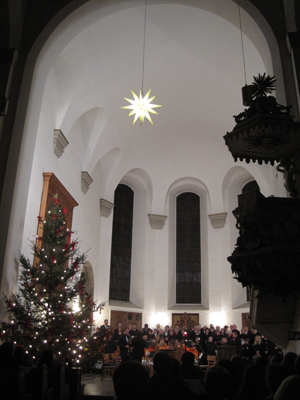| |
 |
 |
 |
| Comment on this report, or find other reports. |
 |
| Our Mystery Worshippers are volunteers who warm church pews for us around the world. If you'd like to become a Mystery Worshipper, start here. |
 |
| Find out how to reproduce this report in your church magazine or website. |
|
|
| 1895: Margarethenkirche, Gotha, Germany |
 |
 |
 |
Mystery Worshipper:
Portola.
The church:
Margarethenkirche,
Gotha, Germany.
Denomination:
Evangelische Kirche
in Mitteldeutschland (Evangelical Church in Middle Germany).
The building:
The Margarethenkirche was originally a Romanesque Basilica,
first documented in 1064. From 1494 until 1531 it was restructured
into a late-Gothic hall church. The pastor of this church joined
the Lutheran Reformation in 1522/23. The church was burned-out
twice and was damaged in the Second World War. Another restructuring
of the church was accomplished after the reunification of Germany
in 1990. A glass wall was positioned under the organ loft, creating
rooms for winter worship services and congregational activities.
The church is open daily and visitors are offered coffee behind
this glass partition.
The church:
Before the reunification of Germany, Gotha was part of the German
Democratic Republic, which means that the Christian community
endured 40 years of atheist oppression and propaganda, which
has left its marks: Christians are a small minority (about 10
per cent of the population) and the vast majority has no relationship
to a church. The congregational newsletter reveals that this
church – in affiliation with neighbouring churches – offers
an impressive variety of groups, choirs, concerts and worship
experiences. There is a special emphasis on reaching out to
children.
The neighbourhood:
Gotha is a small city of 52,000 in the middle of Germany just
north of the Thuringian Forest mountains. It is one of the oldest
habitations in the state of Thuringia, first mentioned in 775.
The most prominent feature of this city is the Palace of Friedenstein,
the former ducal palace, built in 1643-55, Germany’s
oldest early Baroque palace.
The cast:
The pastor, Herr Pfarrer Martin Hundertmark, delivered the sermon
and also sang with the choir. Music was provided by the Bach
Choir Gotha (I counted 56 singers), supplemented by the Lebensgeister
(Life Spirits), a children's choir (20 singers), and the ThüringBarock
instrumental group. Soloists were Frau Julia Kirchner and Herr
Nico Eckert. All was under the direction of Herr Jens Goldhardt,
musical director, with Herr Thomas Kahle presiding at the organ.
The date & time:
6 January 2010, 7.30pm. It was a cold night (-10°C). Almost
all of Germany was covered with a solid layer of snow. The streets
of Gotha were snowy, slick and icy, which made entering a warm
and cosy church even more inviting.
What was the name of the
service?
"I stand here at your manger," Cantate worship service
on the feast of Epiphany. Featured was part VI of JS Bach's
Christmas Oratorio, the part which is intended for Epiphany.
Despite the fact that Epiphany is supposed to be the crowning
finale of the season of Christmas, Protestant churches in Germany
do not offer worship services then (unless it happens to be
on a Sunday). It was a rare treat to find a church that not
only celebrated Epiphany, but did so with special music.
How full was the building?
The nave of the church was packed; I estimate that 200 to 250 people were present. The only empty seats were those with no view of the altar area.
Did anyone welcome you personally?
As we entered we were given a folded sheet with the order of
worship, which included the hymns and the text of the oratorio.
We also received a small Christmas candle with a wax protector.
The entrance area was crowded, and the woman passing out programs
and candles said to those entering, "I don't know which
of you are worshipers or members of the choir!" Apparently
members of the choir were not supposed to take a candle so that
they could hold their music with both hands. I found this greeting
refreshingly candid.
Was your pew comfortable?
The church pews were padded, and thus comfortable.
How would you describe the pre-service
atmosphere?
The pre-service atmosphere was striking. The church was dark;
only the altar area was lighted. A Christmas tree with straw
stars, red ribbons and white electric lights was at the front.
Hanging above the altar area was a large, lighted Herrnhuter
star. There was a hum of conversation in the congregation.
As people entered, there were quiet exchanges of greeting among
people who knew one another. The people behind us were trying
to figure out if they were at a concert or a worship service.
Since they did not have to pay an entrance fee, they finally
decided that it must be a service and that they would thus put
something extra in the collection plate.
What were the exact opening words of the
service?
The first words of the service consisted of a poem (which might
have been the first line of a hymn): "Have you seen the
star?"
What books did the congregation use during the
service?
No books were necessary, as the worship program contained all
the hymns the congregation would be singing. The liturgical
parts of the service did not have musical notes so that only
those who were familiar with the liturgy could sing along.
What musical instruments were played?
The singing of the hymns was accompanied by the organist. For
the Bach oratorio there was an orchestra of 12 musicians, which
included trumpets and tympani.

Did anything distract you?
The only distraction in this well-organised service came at
the start of the sermon when the electric lights of the nave
were turned on. The pastor began by announcing Jesus as the
light of the world and said to us: "Let us be part of this
light by sharing the peace light of Bethlehem." He descended
the pulpit and lit a candle from a flame under the Christmas
tree: a flame that had literally been brought from Bethlehem
to Germany and been dispersed throughout the country. This light
was distributed by the choir children, who lit the candles of
the worshipers. This festive act would have been more effective
if the nave had remained dark. Turning on the lights was completely
unnecessary and it spoiled the intended symbolism, namely, the
spreading of the light of Christ into the darkness. After the
distribution the electric lights were turned off again, but
something of the enchanting atmosphere had been lost.
Was the worship stiff-upper-lip, happy clappy, or
what?
The service was formal and liturgical, but not stiff. The liturgy
was sung by the choir, who sang the opening words of liturgical
sentences and also led the congregation in the a cappella
responses. This liturgical singing was richly satisfying.
Exactly how long was the sermon?
15 minutes.
On a scale of 1-10, how good was the preacher?
7 – Pastor Hundertmark was easy to listen to because he
had a natural, unassuming style of speaking. He offered solid
content and his sermon did justice to Epiphany, for which I
was grateful.
In a nutshell, what was the sermon
about?
The many small lights in the congregation make up a big light.
There are conflicts in the world that seem to negate the light
of Christ. Christians are called to protect the light of Christ
and take it into dark places. On Christmas Eve we celebrate
that God took on our poverty in order to bind himself with us
and to remove all barriers between him and us. On Epiphany God
revealed himself to the Magi, which was a meeting with the world.
A new day dawned for the earth. When one can see a brother or
sister in the face of every person, there is no more darkness.
Which part of the service was like being in
heaven?
Hearing part VI of the Christmas Oratorio was heavenly. It is
striking that Bach used the melody of a Good Friday hymn (O
Haupt voll Blut und Wunden, "O Sacred Head Now
Wounded") to open and close his Christmas Oratorio. With
this melody he proclaims the message that the incarnation did not culminate in Bethlehem but on Golgotha. Bach transformed
this passion chorale into a triumphant Easter hymn, using trumpets
and tympani to celebrate God's victory over all deadly enemies.
Christmas, Good Friday and Easter come together in this victorious
finale, providing a foretaste of eternal glory.
And which part was like being in... er... the other place?
This service was so magnificent that it made me realise that
I am not yet ready to sing with the angels. I usually don't
worry about how well or how poorly I sing in church, but on
this evening my own singing voice seemed scratchy, nasal, gasping
and just inadequate within the setting of this service. During
the singing of the hymns I felt the gap between heaven and the
"other place" in myself.
What happened when you hung around after the service looking lost?
It was not possible to hang around in the narrow entrance area
looking lost. There was a conglomeration of visitors and choir
members at the back of the church trying to sort themselves
out or converse with one another. Anyone loitering around would
have been blocking the flow of people trying to leave.
How would you describe the after-service
coffee?
There was no after-service coffee, but that would be asking too much after such a lovingly prepared worship experience. In any case, there would not have been enough room to accommodate all the visitors.
How would you feel about making this church your regular (where 10 = ecstatic, 0 = terminal)?
8 – It would be a privilege to belong to this Christian
community. It is impressive that a relatively small congregation
could offer a Cantate worship service of this caliber on Epiphany.
An East German church musician informed me that there is a solidarity
among singers and musicians in the former GDR; that they are
ready and willing to travel large distances and perform for
a lower salary than usual in order that fine music can be offered
on festive occasions.
Did the service make you feel glad to be a
Christian?
Yes. This Epiphany celebration embodied everything that I hope
to experience in a worship service: respect for tradition, an
unpretentious proclamation of the gospel, all generations involved,
creativity, reverence, cheerfulness, quality music.
What one thing will you remember about all this in seven days' time?
There are two chorales in part VI of the Christmas Oratorio.
The first one is called "Ich steh an deiner Krippen
hier"("I stand here at your manger"). The
children joined in for the first time, and their voices could
be clearly heard singing the moving words of this chorale. It
was an exquisite moment that created moist eyes among the listeners.
I will not only remember this moment in a week, but forever. |
|
|
 |
 |
 |
| We rely on voluntary donations to stay online. If you're a regular visitor to Ship of Fools, please consider supporting us. |
 |
 |
 |
| The Mystery Pilgrim |
 |
| One of our most seasoned reporters makes the Camino pilgrimage to Santiago de Compostela in Spain. Read here. |
 |
 |
 |
| London churches |
 |
| Read reports from 70 London churches, visited by a small army of Mystery Worshippers on one single Sunday. Read here. |
| |
|
|
|
|


